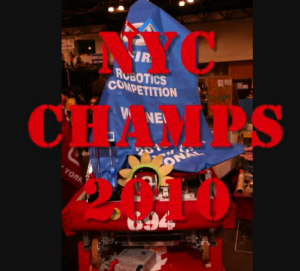I wanted to edit a three minute video down to less than 15 seconds. I’ve never done this before and don’t have any special software. And I needed to do it in an hour. What to do? What to do?
Why the urgency?
I was giving an Ignite style presentation on Stuy Pulse’s journey this season (FIRST Robotics team #694). Since Ignite slides are 15 seconds in length, I originally decided to go with a static picture. The night before my presentation, an alum of the team sent out a really good 3 minute video. I thought it would make my presentation much better to include one 15 second “slide” of video.
Where I started
The original video is 3 minutes and 36 seconds. I decided it would be nice to show kicking a goal in autonomous (no humans involved), driving over the bump/ramp and hanging.
How I did it
- Note that I have Windows Movie Maker on my machine which I can use for basic editing. The shortcut disappeared, but I can create a new one pointing to C:\Program Files\Movie Maker\moviemk.exe.
- Download the video using ClipNabber so I would have a copy of it locally. This downloaded the clip as an .mp4 file.
- Since Windows media player doesn’t support .mp4 files, I needed to convert it to another format. I downloaded the free QuickMedia converter which was a 45 MB file. Thanks to the Microsoft forum for the idea. Converting the file from .mp4 to .wmv took 2 minutes.
- In Windows Movie Maker, import the .wmv file.
- Play the video using the navigation icons to split the video into pieces. The relevant buttons were:
- Play – to start it
- Split – to create a clip boundary (start of end the clip)
- Previous/Next frame for precision
- Drag the three completed clips to the storyboard
- File > Save movie file
How did it work?
This process was good for some rough editing. I met my goal of having a clip under 15 seconds showing these three things. For “real” editing, you’d want a better product of course.
The final product
The completed video does show what I wanted. I didn’t edit out the sound because I knew the speakers would be off during my presentation. The words that went with that slide were:
red al-liance! ,<clap><clap>, <clap><clap><clap>
blue al-liance! ,<clap><clap>, <clap><clap><clap>
hang! hang! hang!
if 694 wins this, we go to nationals!
<pause>
Then the next slide is a screenshot of the congratulations message; the one at the beginning of this post.
—
And yes, I got permission from the video creator to do this and blog about it.
